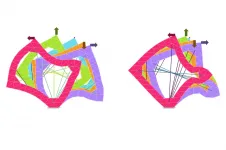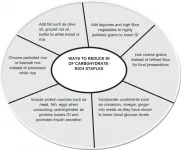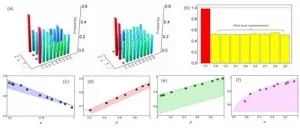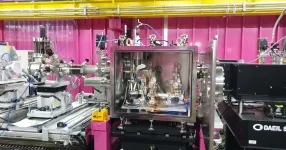(Press-News.org) Imagine a robot.
Perhaps you've just conjured a machine with a rigid, metallic exterior. While robots armored with hard exoskeletons are common, they're not always ideal. Soft-bodied robots, inspired by fish or other squishy creatures, might better adapt to changing environments and work more safely with people.
Roboticists generally have to decide whether to design a hard- or soft-bodied robot for a particular task. But that tradeoff may no longer be necessary.
Working with computer simulations, MIT researchers have developed a concept for a soft-bodied robot that can turn rigid on demand. The approach could enable a new generation of robots that combine the strength and precision of rigid robots with the fluidity and safety of soft ones.
"This is the first step in trying to see if we can get the best of both worlds," says James Bern, the paper's lead author and a postdoc in MIT's Computer Science and Artificial Intelligence Laboratory (CSAIL).
Bern will present the research at the IEEE International Conference on Soft Robotics next month. Bern's advisor, Daniela Rus, who is the CSAIL director and the Andrew and Erna Viterbi Professor of Electrical Engineering and Computer Science, is the paper's other author.
Roboticists have experimented with myriad mechanisms to operate soft robots, including inflating balloon-like chambers in a robot's arm or grabbing objects with vacuum-sealed coffee grounds. However, a key unsolved challenge for soft robotics is control -- how to drive the robot's actuators in order to achieve a given goal.
Until recently, most soft robots were controlled manually, but in 2017 Bern and his colleagues proposed that an algorithm could take the reigns. Using a simulation to help control a cable-driven soft robot, they picked a target position for the robot and had a computer figure out how much to pull on each of the cables in order to get there. A similar sequence happens in our bodies each time we reach for something: A target position for our hand is translated into contractions of the muscles in our arm.
Now, Bern and his colleagues are using similar techniques to ask a question that goes beyond the robot's movement: "If I pull the cables in just the right way, can I get the robot to act stiff?" Bern says he can -- at least in a computer simulation -- thanks to inspiration from the human arm. While contracting the biceps alone can bend your elbow to a certain degree, contracting the biceps and triceps simultaneously can lock your arm rigidly in that position. Put simply, "you can get stiffness by pulling on both sides of something," says Bern. So, he applied the same principle to his robots.
The researchers' paper lays out a way to simultaneously control the position and stiffness of a cable-driven soft robot. The method takes advantage of the robots' multiple cables -- using some to twist and turn the body, while using others to counterbalance each other to tweak the robot's rigidity. Bern emphasizes that the advance isn't a revolution in mechanical engineering, but rather a new twist on controlling cable-driven soft robots.
"This is an intuitive way of expanding how you can control a soft robot," he says. "It's just encoding that idea [of on-demand rigidity] into something a computer can work with." Bern hopes his roadmap will one day allow users to control a robot's rigidity as easily as its motion.
On the computer, Bern used his roadmap to simulate movement and rigidity adjustment in robots of various shapes. He tested how well the robots, when stiffened, could resist displacement when pushed. Generally, the robots remained rigid as intended, though they were not equally resistant from all angles.
Bern is building a prototype robot to test out his rigidity-on-demand control system. But he hopes to one day take the technology out of the lab. "Interacting with humans is definitely a vision for soft robotics," he says. Bern points to potential applications in caring for human patients, where a robot's softness could enhance safety, while its ability to become rigid could allow for lifting when necessary.
"The core message is to make it easy to control robots' stiffness," says Bern. "Let's start making soft robots that are safe but can also act rigid on demand, and expand the spectrum of tasks robots can perform."
INFORMATION:
Written by Daniel Ackerman, MIT News Office
The models used to produce global climate scenarios may overestimate the energy and emission savings from improved energy efficiency, warns new research led by academics at the University of Sussex Business School and the University of Leeds.
In a review of 33 studies, the researchers find that economy wide rebound effects may erode around half of the energy and emission savings from improved energy efficiency.
These rebound effects result from individuals and businesses responding to the benefits of improved energy efficiency - such as cheaper heating, lighting and travel. These responses improve quality-of-life, raise productivity and boost industrial competitiveness, ...
Professor Christiani Jeyakumar Henry, Senior Advisor of Singapore Institute of Food and Biotechnology Innovation (SIFBI), Agency for Science, Technology and Research (A*STAR) and his team have developed a Glycaemic Index (GI) glossary of non-Western foods. The research paper (attached PDF) was published in Nutrition & Diabetes on 6 Jan 2021: https://doi.org/10.1038/s41387-020-00145-w.
Observational studies have shown that the consumption of low glycaemic index (GI) foods is associated with a lower risk of type 2 diabetes mellitus (T2DM), significantly less insulin resistance and a lower prevalence of the metabolic syndrome. ...
Recently, research team led by academician GUO Guangcan from CAS Key Laboratory of Quantum Information of the University of Science and Technology of China (USTC) of CAS, has made an important progress in quantum information theory. Prof. LI Chuanfeng and Prof. XIANG Guoyong from the team, cooperated with Dr. Strelstov from University of Warsaw, investigated the imaginary part of quantum theory as a resource, and several important results have been obtained. Relevant results are now jointly published as Editors' Suggestion in Physical Review Letters and Physical Review A.
Complex number is a mathematical ...
It is millions of trillions of times brighter than the sunlight and a whopping 1,000 trillionth of a second, appropriately called the instantaneous light. It is the X-ray Free Electron Laser (XFEL) light that opens a new scientific paradigm. Combining it with AI, an international research team has succeeded in filming and restoring the 3D structure of nanoparticles that share structural similarities with viruses. With the fear of a new pandemic growing around the world due to COVID-19, this discovery is attracting the attention among academic circles for imaging the structure of the virus with both high accuracy and speed.
An international team of researchers from POSTECH, National University of ...
Targeted, efficient and with few side effects: A new method for combating periodontitis could render the use of broad-spectrum antibiotics superfluous. It was developed and tested for the first time by a team from Martin Luther University Halle-Wittenberg (MLU), the Fraunhofer Institute for Cell Therapy and Immunology IZI and Periotrap Pharmaceuticals GmbH. The aim is to neutralise only bacteria that cause periodontitis while sparing harmless bacteria. The study appeared in the Journal of Biological Chemistry.
Periodontitis is a common bacterial inflammation of the gums. According to the World Health Organization WHO Oral ...
Ask Eric Weaver about pandemics, and he's quick to remind you of a fact that illustrates the fleeting nature of human memory and the proximal nature of human attention: The first pandemic of the 21st century struck not in 2019, but 2009.
That's when the H1N1/09 swine flu emerged, eventually infecting upwards of 1.4 billion people -- nearly one of every five on the planet at the time. True to the name, swine flus jump to humans from pigs. It's a phenomenon that has been documented more than 400 times since the mid-2000s in the United States alone.
"They're considered the great mixing vessel," said Weaver, associate professor of biological sciences at the University of Nebraska-Lincoln. "They're susceptible to their own circulating ...
Parents who reported more hassles using a child car seat or booster seat - such as the child is uncomfortable or having to make multiple trips in a day - were less likely to follow recommendations from the American Academy of Pediatrics (AAP) on child passenger safety, according to a study published in the journal Academic Pediatrics.
Researchers obtained information about transportation safety behaviors and 20 hassles when using child car seats among 238 socioeconomically and racially diverse parents of children 1 to 10 years of age. Eighty percent of parents reported at least a little bit of a problem with one ...
Neurodegenerative disorders such as Parkinson's and Alzheimer's disease are in the firing line after researchers identified an attractive therapeutic drug target.
An international collaboration, co-led by University of Queensland researchers, has isolated and analysed the structure and function of a protein found in the brain's nerve fibres called SARM1.
Dr Jeff Nanson said the protein was activated when nerve fibres were damaged by injury, disease, or as a side effect of certain drugs.
"After a damaging incident occurs, this protein often induces ...
Fireworks are used in celebrations around the world, including Independence Day in the U.S., the Lantern Festival in China and the Diwali Festival in India. However, the popular pyrotechnic displays emit large amounts of pollutants into the atmosphere, sometimes causing severe air pollution. Now, researchers reporting in ACS' Environmental Science & Technology have estimated that, although so-called environmentally friendly fireworks emit 15-65% less particulate matter than traditional fireworks, they still significantly deteriorate air quality.
Fireworks displays can cause health problems, such as respiratory ailments, because they ...
Wine lovers recognize that a perfectly paired wine can make a delicious meal taste even better, but the reverse is also true: Certain foods can influence the flavors of wines. Now, researchers reporting in ACS' Journal of Agricultural and Food Chemistry have explored how lipids -- fatty molecules abundant in cheese, meats, vegetable oils and other foods -- interact with grape tannins, masking the undesirable flavors of the wine compounds.
Tannins are polyphenolic compounds responsible for the bitterness and astringency of red wines. Wine testers have noticed that certain foods reduce these sensations, improving the flavor of a wine, but scientists aren't sure why. Some studies have ...






